Dali Kingdom 大理國 Dablit Guaif | |||||||||||||
|---|---|---|---|---|---|---|---|---|---|---|---|---|---|
| |||||||||||||
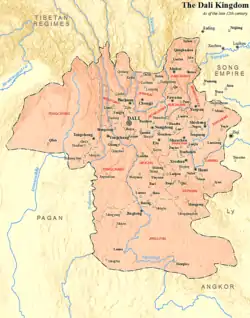 Map of Dali Kingdom in late 12th century | |||||||||||||
| Status | Song dynasty tributary state (982–1253) | ||||||||||||
| Capital | Yangjumie (in present-day Dali Town, Yunnan) | ||||||||||||
| Common languages | Written Classic Chinese Bai | ||||||||||||
| Religion | Buddhism | ||||||||||||
| Government | Monarchy | ||||||||||||
| Emperor | |||||||||||||
• 937–944 | Duan Siping | ||||||||||||
• 1081–1094 | Duan Zhengming | ||||||||||||
• 1096–1108 | Duan Zhengchun | ||||||||||||
• 1172–1200 | Duan Zhixing | ||||||||||||
• 1251–1254 | Duan Xingzhi | ||||||||||||
| History | |||||||||||||
• Established | 937 | ||||||||||||
| 1094 | |||||||||||||
• Reestablished | 1096 | ||||||||||||
• Conquered by the Mongol Empire | 1253 | ||||||||||||
| |||||||||||||
| Today part of | China Laos Myanmar | ||||||||||||
| Dali Kingdom | |||||||||
|---|---|---|---|---|---|---|---|---|---|
| Chinese name | |||||||||
| Traditional Chinese | 大理國 | ||||||||
| Simplified Chinese | 大理国 | ||||||||
| Literal meaning | State of Dali | ||||||||
| |||||||||
| Alternative Chinese name | |||||||||
| Traditional Chinese | 後大理 後理國 | ||||||||
| Simplified Chinese | 后大理 后理国 | ||||||||
| |||||||||
| Vietnamese name | |||||||||
| Vietnamese alphabet | Vương quốc Đại Lý | ||||||||
| Hán-Nôm | 王國大理 | ||||||||
| Bai name | |||||||||
| Bai | Dablit Guaif | ||||||||
| Part of a series on the |
| History of China |
|---|
The Dali Kingdom, also known as the Dali State (simplified Chinese: 大理国; traditional Chinese: 大理國; pinyin: Dàlǐ Guó; Bai: Dablit Guaif), was a dynastic state situated in modern Yunnan province, China from 937 until 1253. In 1253, it was conquered by the Mongols but members of its former ruling house continued to administer the area as tusi chiefs under the auspices of the Yuan dynasty until the Ming conquest of Yunnan in 1382.[1] Today the former capital of the Dali Kingdom is still called Dali in modern Yunnan Province.
Name
The Dali Kingdom takes its name from Dali City. Famed for its high quality marble, Dali (dàlǐ 大理) literally means "marble" in Chinese.[2]
Dali marble is famous throughout Asia and among collectors of gemstones all over the world. For a few square inches of Shuimohuashi, a particularly precious type of marble, dealers in Hong Kong or Shanghai can charge up to $20,000. For more than 1,000 years Dali has been known as the town of marble; indeed, the Chinese word dali means “marble.”[2]
— Barbara A. West
History
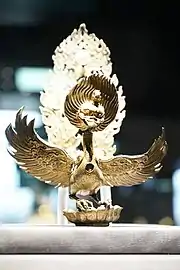
Origins
Nanzhao was overthrown in 902 and three dynasties followed in quick succession before Duan Siping seized power in 937, establishing himself at Dali.[3] The Duan clan professed to have Han ancestry.[4] Yuan dynasty records said the Duan family came from Wuwei in Gansu:
Yuan records claim that the Dali kingdom’s Duan rulers originally came from Wuwei Commandery in modern-day Gansu Province, but this is not confirmed by Song or Dali sources. A significant change from Nanzhao is apparent in Dali rulers’ naming practices, which generally do not follow the patronymic linkage system. This suggests that the Dali elites presented themselves as more “Chinese” than their Nanzhao counterparts.[5]
— Megan Bryson
Relations with the Song dynasty
Dali's relationship with the Song was cordial throughout its entire existence. Dali congratulated the Song dynasty on the conquest of Later Shu in 965 and voluntarily established tribute relations in 982. It was however essentially an independent state. At times the Song even declined offers of tribute.[3] The Song founder Song Taizu declared all land south of the Dadu River to be Dali territory and did not desire to pursue any further claims to avoid the Tang dynasty's disastrous efforts against Nanzhao.[6]
Dali relations with the Song differed markedly from Nanzhao-Tang relations. When the first Song emperor, Taizu, came to power, he declared that, in light of Tang difficulties in the Southwest, he would forfeit the Yue and Sui Commanderies and use the Dadu River as the border with Dali. His successors followed this policy, so contact between the Song and Dali was minimal. Song records show reluctance to engage with Dali directly in any way, even through the standard tributary relationship of vassal (Dali) and lord (Song). Because of Song officials’ wariness, Dali was only allowed to offer tribute at the Song court on three occasions. Their requests to offer tribute were repeatedly rejected on the grounds that they would cause trouble for Song, as Nanzhao had for Tang.[7]
— Megan Bryson
Dali's primary importance to the Song dynasty was its horses, which were highly prized and sought after as military assets, especially after the fall of the Northern Song. They were described by a Song official in the following passage:
These horses possess a shape [that is] quite magnificent. They stand low with a muscular front, very similar to the shape of a chicken. The diaphragm is broad, shoulders thick, waist flat, and back round. They are trained to squat on their rear ends like a dog. They easily climb steep terrain on command and possess both speed and agility in chase. They have been raised on bitter buckwheat, so they require little to maintain. How could a horse like this not be considered a good horse?[8]
Dazhong Kingdom (1094-1096)
In 1094, the former prime minister Gao Shengtai forced King Duan Zhengming to relinquish the throne to him and renamed the Dali Kingdom to "Dazhong Kingdom". Gao Shengtai ruled briefly until his death in 1096, after which the throne was returned to the Duan family. Duan Zhengming's younger brother, Duan Zhengchun, became the new ruler and restored the kingdom's former name.[7]
The Gao of Beisheng claimed descent from Gao Shengtai 高昇泰, who usurped the throne of the Dali kingdom c.1094 for approximately one year. According to the Yuan History, Gao Zhisheng 高智升 sent his grandson, Gao Dahui 高大惠, to administer the area after the fall of the Nanzhao kingdom. The Gao served as the Native Officials of Beisheng sub-prefecture for eleven generations during the Ming dynasty. The Ming appointed the first Gao Ce 高策 in recognition of his meritorious military service in 1389, and the eleventh Gao Shichang 高世昌 inherited the position of Vice Magistrate of rank four in 1630.[9]
— Huang Caiwen
Intervention in Đại Việt
According to a Vietnamese stone inscription, in 1096 a Dali magician was said to have plotted a conspiracy to murder King Lý Nhân Tông. After the death of Nhân Tông in 1127, his adopted son (by concubine) named Zhizhi had escaped to Dali, changed his surname to Zhao, and assumed the title pingwang (peaceful king). When he learned that his older brother, King Lý Thần Tông, had died in 1137, Zhizhi returned to Đại Việt and attacked Lý Anh Tông with 3,000 Dali troops. However, he was defeated and executed.[10]
Fall
In 1252 Möngke Khan placed his brother Kublai in charge of invading Dali. In 1253 Kublai's army crossed the Jinsha River and received the surrender of Duan Xingzhi, who presented to Möngke in 1256 maps of Yunnan. Duan Xingzhi of Dali was enfeoffed as Maharaja (摩诃罗嵯),[11] and the Duan imperial family continued to hold the title of Maharaja in Yunnan as vassals to the Mongols under the supervision of Borjigin imperial princes and Muslim governors. The Duan family reigned in Dali while the governors served in Kunming. After the Ming conquest of Yunnan,[12] the members of the Duan clan were scattered in various distant areas of China by the Hongwu Emperor.[13]
Yunnan under the Yuan dynasty
The Duan family governed Yunnan's various indigenous peoples for eleven generations until the end of Mongol rule. They willingly contributed soldiers to the Mongol campaign against the Song dynasty. In 1271, they aided the Yuan dynasty in putting down a Mongol rebellion in Yunnan.[13]
In 1274, Ajall Shams al-Din Omar was assigned by Kublai to stabilize Yunnan. He instituted a native chieftain system that came to be known as tusi which assigned ranks and posts to native chieftains. Under this institution of "rule based on native customs" the locals retained much of their autonomy with the exception of three obligations. One, they would provide surrendered troops to the Yuan government. Two, local chieftains would provide tribute to the Yuan court. Three, they would follow the rules of appointment, succession, promotion, degradation, reward, and punishment of native chieftains created by the Yuan court.[13]
Yuan rule also introduced a significant Muslim influence into Yunnan.[13]
The King of Dali Duan Gong was married to the Mongol Borjigin princess Agai, daughter of the Yuan dynasty Prince of Liang, Basalawarmi. They had a son and a daughter, Duan Sengnu.[14][15][16][17][18][19][20][21][22][23] their children were also called Duan Qiangna and Duan Bao.[24] However the Mongols feared the power of Duan Gong and killed him. Duan Sengnu raised Duan Bao to take revenge against Basalawarmi for the killing of Duan Gong.[25][26] A play was made based on these events.[27][28] According to Yuan documents, the Duan family were originally ethnic Han from Wuwei commandery, Gansu.[5][29][30] Other Duan families also originated from Wuwei.[31][32]
Conquest of Yunnan by the Ming dynasty
In 1381, the Ming dynasty dispatched 300,000 troops to crush the Yuan remnants in Yunnan.
The Duan clan, who helped the Yuan dynasty against a Red Turban Rebellion attack from Sichuan, also fought against the Ming army. Duan Gong refused to surrender by writing to Fu Youde, making it clear that Dali could only be a tributary to the Ming. Fu Youde attacked and crushed Duan Gong's realm after a fierce battle. The Duan brothers were taken captive and escorted back to the Ming capital.[33]
Government
Under the influence of Chinese officials present from early times,[34] the Dali elite used Chinese script supplemented by Bai characters, which were themselves constructed based on Chinese characters.[35] The Dali court granted hereditary fiefs to pre-existing clan chiefs, in particular the Duan, Gao, Yang, and Dong clans, to win over their support. Some administrative units were designated semi-autonomous military divisions. Similarly to the Nanzhao military, the Dali military consisted of a standing army, townsfolk peasant-soldiers and indigenous militia.[36]
Language and ethnicity

Extant sources from Nanzhao and the Dali Kingdom show that the ruling elite used Chinese script.[37] The vast majority of Dali sources are written in Classical Chinese.[38] However the ruling elite also used Bai language for communication, but no attempt was made to standardize or popularize the script, and it remained an unofficial writing system.[39]
Today, most Bai people trace their ancestry to Nanzhao and the Dali Kingdom, but records from those kingdoms do not mention the Bai. The earliest references to "Bai people", or the "Bo", are from the Yuan dynasty. During the Ming dynasty, the Bai were also known as "Minjia" (civilians). A Bai script using Chinese characters was mentioned during the Ming dynasty.[40]
According to Stevan Harrell, while the ethnic identity of Nanzhao's ruling elite is still disputed, the subsequent Yang and Duan dynasties were both definitely Bai.[41]
Religion
A version of Buddhism known as Azhali existed in Yunnan since the 9th century. The last king of Nanzhao established Buddhism as the state religion and many Dali kings continued the tradition. Ten of Dali's 22 kings retired to become Buddhist monks.[42]
Fan Chengda (1126-1193) encountered a Dali trade mission and noted that they sought Chinese literature, medical texts, Buddhist scriptures, and dictionaries in return for horses. He marveled that "these people all possessed proper etiquette, and carried and recited Buddhist scriptural books."[43]
Gallery
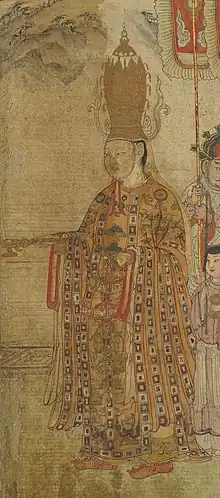 Duan Zhixing (r. 1171–1200)
Duan Zhixing (r. 1171–1200).jpg.webp)
.jpg.webp)
.jpg.webp)
.jpg.webp)
Family tree of monarchs
| Family Tree of the Emperors of Dali | |||||||||||||||||||||||||||||||||||||||||||||||||||||||||||||||||||||||||||||||||||||||||||||||||||||||||||||||||||||||||||||||||||||||||||||||||||||||||||||||||||||||||||||||||||||||||||||||||||||||||||||||||||||||||||||||||||||||||||||||||||||||||||||||||||||||||||||||||||||||||||||||||||||||||||||||||||||||||||||||||||||||||||||||||||||||||||||||||||||||||||||||||||||||||||||||||||||||||||||||||||||||||||||||||||||||||||||||||||||||||||||||||||||||||||||||||||||||||||||||||||||||||||||||||||||||||||||||||||||||||||||||||||||||||||||||||||||||||||||||||||||||||||||||||||||||||||||||||||||||||||||||||||||||||||||||||||||||||||||||||||||||||||||||||||||||||||||||||||||||||||||||||||||||||||||||||||||||||||||||||||||||||||||||||||||||||||||||||||||||||||||||||||||||||||||||||||||||||||||||||||||||||||||||||||||||||||||||||||||||||||||||||||||||||||||||||||||||||||||||||||||||||||||||||||||||||||||||||||||||||||||||||||||||||||||||||||||||||||||||||||||||||||||||||||||||||||||||||||||||
|---|---|---|---|---|---|---|---|---|---|---|---|---|---|---|---|---|---|---|---|---|---|---|---|---|---|---|---|---|---|---|---|---|---|---|---|---|---|---|---|---|---|---|---|---|---|---|---|---|---|---|---|---|---|---|---|---|---|---|---|---|---|---|---|---|---|---|---|---|---|---|---|---|---|---|---|---|---|---|---|---|---|---|---|---|---|---|---|---|---|---|---|---|---|---|---|---|---|---|---|---|---|---|---|---|---|---|---|---|---|---|---|---|---|---|---|---|---|---|---|---|---|---|---|---|---|---|---|---|---|---|---|---|---|---|---|---|---|---|---|---|---|---|---|---|---|---|---|---|---|---|---|---|---|---|---|---|---|---|---|---|---|---|---|---|---|---|---|---|---|---|---|---|---|---|---|---|---|---|---|---|---|---|---|---|---|---|---|---|---|---|---|---|---|---|---|---|---|---|---|---|---|---|---|---|---|---|---|---|---|---|---|---|---|---|---|---|---|---|---|---|---|---|---|---|---|---|---|---|---|---|---|---|---|---|---|---|---|---|---|---|---|---|---|---|---|---|---|---|---|---|---|---|---|---|---|---|---|---|---|---|---|---|---|---|---|---|---|---|---|---|---|---|---|---|---|---|---|---|---|---|---|---|---|---|---|---|---|---|---|---|---|---|---|---|---|---|---|---|---|---|---|---|---|---|---|---|---|---|---|---|---|---|---|---|---|---|---|---|---|---|---|---|---|---|---|---|---|---|---|---|---|---|---|---|---|---|---|---|---|---|---|---|---|---|---|---|---|---|---|---|---|---|---|---|---|---|---|---|---|---|---|---|---|---|---|---|---|---|---|---|---|---|---|---|---|---|---|---|---|---|---|---|---|---|---|---|---|---|---|---|---|---|---|---|---|---|---|---|---|---|---|---|---|---|---|---|---|---|---|---|---|---|---|---|---|---|---|---|---|---|---|---|---|---|---|---|---|---|---|---|---|---|---|---|---|---|---|---|---|---|---|---|---|---|---|---|---|---|---|---|---|---|---|---|---|---|---|---|---|---|---|---|---|---|---|---|---|---|---|---|---|---|---|---|---|---|---|---|---|---|---|---|---|---|---|---|---|---|---|---|---|---|---|---|---|---|---|---|---|---|---|---|---|---|---|---|---|---|---|---|---|---|---|---|---|---|---|---|---|---|---|---|---|---|---|---|---|---|---|---|---|---|---|---|---|---|---|---|---|---|---|---|---|---|---|---|---|---|---|---|---|---|---|---|---|---|---|---|---|---|---|---|---|---|---|---|---|---|---|---|---|---|---|---|---|---|---|---|---|---|---|---|---|---|---|---|---|---|---|---|---|---|---|---|---|---|---|---|---|---|---|---|---|---|---|---|---|---|---|---|---|---|---|---|---|---|---|---|---|---|---|---|---|---|---|---|---|---|---|---|---|---|---|---|---|---|---|---|---|---|---|---|---|---|---|---|---|---|---|---|---|---|---|---|---|---|---|---|---|---|---|---|---|---|---|---|---|---|---|---|---|---|---|---|---|---|---|---|---|---|---|---|---|---|---|---|---|---|---|---|---|---|---|---|---|---|---|---|---|---|---|---|---|---|---|---|---|---|---|---|---|---|---|---|---|---|---|---|---|---|---|---|---|---|---|---|---|---|---|---|---|---|---|---|---|---|---|---|---|---|---|---|---|---|---|---|---|---|---|---|---|---|---|---|---|---|---|---|---|---|---|---|---|---|---|---|---|---|---|---|---|---|---|---|---|---|---|---|---|---|---|---|---|---|---|---|---|---|---|---|---|---|---|---|---|---|---|---|---|---|---|---|---|---|---|---|---|---|---|---|---|---|---|---|---|---|---|---|---|---|---|---|---|---|---|---|---|---|---|---|---|---|---|---|---|---|---|---|---|---|---|---|---|---|---|---|---|---|---|---|---|---|---|---|---|---|---|---|---|---|---|---|---|---|---|---|---|---|---|---|---|---|---|---|---|---|---|---|---|---|---|---|---|---|---|---|---|---|---|---|---|---|---|---|---|---|---|---|---|---|---|---|---|---|---|---|---|---|---|---|---|---|---|---|---|---|---|---|---|---|---|---|---|---|---|---|---|---|---|---|---|---|---|---|---|---|---|---|---|---|---|---|---|---|---|---|---|---|---|---|---|---|---|---|---|---|---|---|---|---|---|---|---|---|---|---|---|---|---|---|---|---|---|---|---|---|---|---|---|---|---|---|---|---|---|---|---|---|---|---|---|---|---|---|---|---|---|---|---|
| |||||||||||||||||||||||||||||||||||||||||||||||||||||||||||||||||||||||||||||||||||||||||||||||||||||||||||||||||||||||||||||||||||||||||||||||||||||||||||||||||||||||||||||||||||||||||||||||||||||||||||||||||||||||||||||||||||||||||||||||||||||||||||||||||||||||||||||||||||||||||||||||||||||||||||||||||||||||||||||||||||||||||||||||||||||||||||||||||||||||||||||||||||||||||||||||||||||||||||||||||||||||||||||||||||||||||||||||||||||||||||||||||||||||||||||||||||||||||||||||||||||||||||||||||||||||||||||||||||||||||||||||||||||||||||||||||||||||||||||||||||||||||||||||||||||||||||||||||||||||||||||||||||||||||||||||||||||||||||||||||||||||||||||||||||||||||||||||||||||||||||||||||||||||||||||||||||||||||||||||||||||||||||||||||||||||||||||||||||||||||||||||||||||||||||||||||||||||||||||||||||||||||||||||||||||||||||||||||||||||||||||||||||||||||||||||||||||||||||||||||||||||||||||||||||||||||||||||||||||||||||||||||||||||||||||||||||||||||||||||||||||||||||||||||||||||||||||||||||||||
Art
Gallery
 Lacquered armour of the Dali Kingdom
Lacquered armour of the Dali Kingdom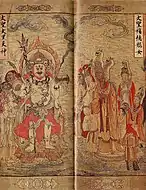 Dali religious painting
Dali religious painting Dali procession of nobles and soldiers
Dali procession of nobles and soldiers Pagoda of Chongsheng Temple, the royal temple of the Dali
Pagoda of Chongsheng Temple, the royal temple of the Dali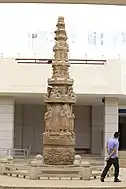 Dharani pillar of Dali, 1220
Dharani pillar of Dali, 1220%252C_Asian_Art_Museum_(6016444771).jpg.webp) Bronze statue of Guanyin from Dali
Bronze statue of Guanyin from Dali Dali vajra sceptre (jingangchu)
Dali vajra sceptre (jingangchu)
Citations
- ↑ Theobald, Ulrich (17 August 2012), "Dali 大理", China Knowledge.
- 1 2 West 2009, p. 79.
- 1 2 Yang 2008a.
- ↑ Frederick W. Mote (2003). Imperial China 900-1800. Harvard University Press. pp. 710–. ISBN 978-0-674-01212-7.
- 1 2 Bryson 2016, p. 41.
- ↑ Heirman, Ann; Meinert, Carmen; Anderl, Christoph (2018). Buddhist Encounters and Identities Across East Asia. BRILL. p. 97. ISBN 978-9004366152.
- 1 2 Bryson 2016, p. 38.
- ↑ Herman 2007, p. 40.
- ↑ Huang 2020, p. 80.
- ↑ Fan 2011, p. 196.
- ↑ Yang 2008c.
- ↑ Frederick W. Mote; Denis Twitchett (26 February 1988). The Cambridge History of China: Volume 7, The Ming Dynasty, 1368-1644. Cambridge University Press. pp. 144–. ISBN 978-0-521-24332-2.
- 1 2 3 4 Yang 2008b.
- ↑ Lee, Lily Xiao Hong; Wiles, Sue (2015). Biographical Dictionary of Chinese Women, Volume II: Tang Through Ming 618 - 1644. Routledge. p. 5. ISBN 978-1317515623.
- ↑ Lee, Lily Xiao Hong; Wiles, Sue, eds. (2014). Biographical Dictionary of Chinese Women: Tang Through Ming, 618-1644. M.E. Sharpe. p. 5. ISBN 978-0765643162.
- ↑ Mair, Victor H, ed. (2016). Imperial China and Its Southern Neighbours. Flipside Digital Content Company Inc. p. 269. ISBN 978-9814620550.
- ↑ Mair, Victor H; Kelley, Liam (2015). Imperial China and Its Southern Neighbours. CHINA SOUTHEAST ASIA History (illustrated, reprint ed.). Institute of Southeast Asian Studies. p. 269. ISBN 978-9814620536.
- ↑ Chen 陈, Lufan 吕范 (1990). 泰族起源问题研究. 国际文化出版公司. pp. 271, 285. ISBN 9787800494970. Retrieved Sep 9, 2008.
- ↑ Mao yi yu lü you: Trade and tours. 1986. p. 19. Retrieved Jul 31, 2007.
- ↑ Istituto italiano per il Medio ed Estremo Oriente, Istituto italiano per l'Africa e l'Oriente (1991). Cina, Volumes 23-25. Istituto italiano per il medio ed estremo oriente. pp. 157, 159. Retrieved Jun 13, 2011.
- ↑ Cina, Volumes 15-16. Istituto italiano per il Medio ed Estremo Oriente, Istituto italiano per l'Africa e l'Oriente. Istituto italiano per il medio ed estremo oriente. 1979. p. 295. Retrieved Jun 13, 2011.
{{cite book}}: CS1 maint: others (link) - ↑ Cina, Volumes 15-16. Istituto italiano per il Medio ed Estremo Oriente, Istituto italiano per l'Africa e l'Oriente. Istituto italiano per il medio ed estremo oriente. 1979. p. 295. Retrieved Jun 13, 2011.
{{cite book}}: CS1 maint: others (link) - ↑ Robinson, David M. (2019). "Part III - A Tough Crowd". In the Shadow of the Mongol Empire. Cambridge University Press. pp. 187–270. ISBN 9781108482448.
- ↑ Bryson 2016, p. 212.
- ↑ Lee, Lily Xiao Hong; Wiles, Sue (2015). Biographical Dictionary of Chinese Women, Volume II: Tang Through Ming 618 - 1644. Routledge. p. 55. ISBN 978-1317515623.
- ↑ Lee, Lily Xiao Hong; Wiles, Sue, eds. (2014). Biographical Dictionary of Chinese Women: Tang Through Ming, 618-1644. M.E. Sharpe. p. 55. ISBN 978-0765643162.
- ↑ Malmqvist, Nils Göran David, ed. (1989). A Selective Guide to Chinese Literature 1900-1949: The Drama. Vol. 4 of Selected Guide to Chinese Literature 1900-1949, Vol 4. European Science Foundation (illustrated ed.). BRILL. p. 126. ISBN 9004090983.
- ↑ Renger, Almut-Barbara; Fan, Xin (2019). Receptions of Greek and Roman Antiquity in East Asia. BRILL. p. 316. ISBN 978-9004370715.
- ↑ Mote, Frederick W. (2003). Imperial China 900-1800. Vol. 0 of Titolo collana (illustrated ed.). Harvard University Press. p. 710. ISBN 0674012127.
- ↑ Mote, Frederick W. (1999). Imperial China 900-1800. Vol. 0 of Titolo collana (2, illustrated ed.). Harvard University Press. p. 710. ISBN 0674445155.
- ↑ Reed, Carrie Elizabeth (2003). A Tang Miscellany: An Introduction to Youyang Zazu. Vol. 57 of Asian thought and culture. Peter Lang. pp. 11, 121. ISBN 0820467472. ISSN 0893-6870. Retrieved Sep 9, 2008.
- ↑ Shang, Huping (2019). The Belt and Road Initiative: Key Concepts. Springer. p. 81. ISBN 978-9811392016.
- ↑ Du Yuting; Chen Lufan. "Did Kublai Khan's conquest of the Dali Kingdom give rise to the mass migration of the Thai people to the south?" (PDF) (Institute for Asian Studies, Kunming ed.). Retrieved 2019-02-18.
{{cite journal}}: Cite journal requires|journal=(help) - ↑ Heirman, Ann; Meinert, Carmen; Anderl, Christoph (2018). Buddhist Encounters and Identities Across East Asia. BRILL. p. 105. ISBN 978-9004366152.
- ↑ Craig Alan Volker; Fred E. Anderson (2015). Education in Languages of Lesser Power: Asia-Pacific Perspectives. John Benjamins Publishing Company. pp. 54–55. ISBN 978-9027269584.
- ↑ Anderson, James A.; Whitmore, John K. (2014). China's Encounters on the South and Southwest: Reforging the Fiery Frontier Over Two Millennia. BRILL. pp. 109–110. ISBN 978-9004282483.
- ↑ Bryson 2013, p. 7.
- ↑ Bryson 2016, p. 40-41.
- ↑ Wang 2004, p. 280.
- ↑ Bryson 2013, p. 6-7.
- ↑ Harrell 1995, p. 87.
- ↑ "Nanzhao State and Dali State". City of Dali. Archived from the original on 2006-09-03.
- ↑ Bryson 2016, p. 40.
References
- Bryson, Megan (2013), Baijie and the Bai
- Bryson, Megan (2016), Goddess on the Frontier: Religion, Ethnicity, and Gender in Southwest China, Stanford University Press, ISBN 978-1503600454
- Fan, Chengda (2011). Hargett, James M. (ed.). Treatises of the Supervisor and Guardian of the Cinnamon Sea: The Natural World and Material Culture of Twelfth-Century China. University of Washington Press. ISBN 978-0-29599-079-8.
- Harrell, Stevan (1995), The History of the History of the Yi, University of Washington Press, pp. 63–91, ISBN 9780295975283, JSTOR j.ctvbtzm9s.5
- Herman, John E. (2007), Amid the Clouds and Mist China's Colonization of Guizhou, 1200–1700, Harvard University Asia Center, ISBN 978-0-674-02591-2
- Huang, Caiwen (2020), The Lancang Guard and the Construction of Ming society in northwest Yunnan
- Wang, Feng (2004). "Language policy for Bai". In Zhou, Minglang (ed.). Language policy in the People's Republic of China: Theory and practice since 1949. Kluwer Academic Publishers. pp. 278–287. ISBN 978-1-4020-8038-8.
- West, Barbara A. (2009), Encyclopedia of the Peoples of Asia and Oceania
- Yang, Bin (2008a), "Chapter 3: Military Campaigns against Yunnan: A Cross-Regional Analysis", Between Winds and Clouds: The Making of Yunnan (Second Century BCE to Twentieth Century CE), Columbia University Press
- Yang, Bin (2008b), "Chapter 4: Rule Based on Native Customs", Between Winds and Clouds: The Making of Yunnan (Second Century BCE to Twentieth Century CE), Columbia University Press
- Yang, Bin (2008c), "Chapter 5: Sinicization and Indigenization: The Emergence of the Yunnanese", Between Winds and Clouds: The Making of Yunnan (Second Century BCE to Twentieth Century CE), Columbia University Press
External links
 Media related to Dali Kingdom at Wikimedia Commons
Media related to Dali Kingdom at Wikimedia Commons
